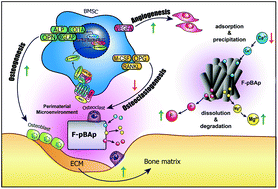Contribution of the in situ release of endogenous cations from xenograft bone driven by fluoride incorporation toward enhanced bone regeneration†
Abstract
Xenograft, namely bone-derived biological apatite (BAp), is widely recognized as a favorable biomaterial in bone tissue engineering owing to its biodegradability, biocompatibility, and osteoconductive properties. Substitutions of endogenous trace ions are thought to improve the osteogenic capacity of xenograft compared with synthetic hydroxyapatite (HAp). In order to modify the physicochemical and biological properties of apatite, different approaches to induce trace ion incorporation have been widely considered. In this study, we demonstrated that the incorporation of fluoride ions into porcine bone-derived biological apatite (pBAp) contributes to altered crystal morphology of the apatite, the sustained release of fluoride, and the in situ release of endogenous trace ions (e.g., magnesium and calcium) into the peripheral tissue microenvironment. This ionic balanced perimaterial microenvironment not only led to superior proliferation and osteogenic differentiation of rat bone mesenchymal stem cells (rBMSCs), but also accelerated new bone formation of the calvarial defect on a rat model via the activation of Wnt/β-catenin signaling. These promising observations may be attributed to the controlled release of endogenous trace ions from the xenograft to the peripheral tissue microenvironment driven by fluoride ion incorporation. Lastly, this study may provide a new insight to strengthen the osteogenicity of xenografts for clinical applications in the future.



 Please wait while we load your content...
Please wait while we load your content...